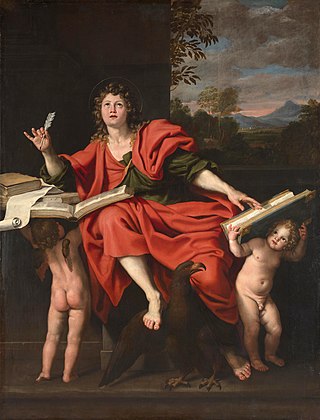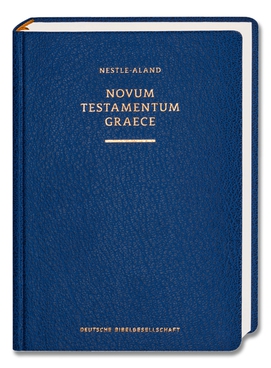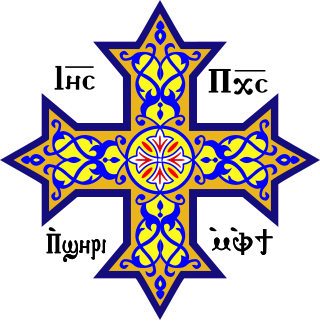
The Hebrew term Abaddon, and its Greek equivalent Apollyon appear in the Bible as both a place of destruction and an angel of the abyss. In the Hebrew Bible, abaddon is used with reference to a bottomless pit, often appearing alongside the place Sheol, meaning the resting place of dead peoples.

The First Epistle of John is the first of the Johannine epistles of the New Testament, and the fourth of the catholic epistles. There is no scholarly consensus as to the authorship of the Johannine works. The author of the First Epistle is termed John the Evangelist, who most modern scholars believe is not the same as John the Apostle. Most scholars believe the three Johannine epistles have the same author, but there is no consensus if this was also the author of the Gospel of John.

The King James Version (KJV), also the King James Bible (KJB) and the Authorized Version, is an Early Modern English translation of the Christian Bible for the Church of England, which was commissioned in 1604 and published in 1611, by sponsorship of King James VI and I. The 80 books of the King James Version include 39 books of the Old Testament, 14 books of Apocrypha, and the 27 books of the New Testament. Noted for its "majesty of style", the King James Version has been described as one of the most important books in English culture and a driving force in the shaping of the English-speaking world.

Asher, in the Book of Genesis, was the last of the two sons of Jacob and Zilpah and the founder of the Israelite Tribe of Asher.

The Peshitta is the standard version of the Bible for churches in the Syriac tradition, including the Maronite Church, the Chaldean Catholic Church, the Syriac Catholic Church, the Syriac Orthodox Church, the Malabar Independent Syrian Church, the Syro-Malankara Catholic Church, the Mar Thoma Syrian Church, the Assyrian Church of the East and the Syro-Malabar Church.
The Johannine Comma is an interpolated phrase (comma) in verses 5:7–8 of the First Epistle of John.

Throughout history, printers' errors, unconventional translations and translation mistakes have appeared in a number of published Bibles. Bibles with features considered to be erroneous are known as Bible errata, and were often destroyed or suppressed due to their contents being considered heretical by some.
Sortes Sanctorum is a late antique text that was used for divination by means of dice. The oldest version of the text may have been pagan, but the earliest surviving example—a 4th- or 5th-century Greek fragment on papyrus—is Christian. The original version had 216 answers available depending on three ordered throws of a single die. It was later revised down to 56 answers for a single throw of three dice. This version was translated into Latin by the time of the council of Vannes (465), which condemned its use. The Latin version was subsequently revised to render it more acceptable to ecclesiastical authorities. This Latin version survives in numerous manuscripts from the early 9th century through the 16th, as well as in Old Occitan and Old French translations. Beginning in the 13th century, the text was sometimes known as the Sortes Apostolorum, a title it shares with at least two other texts.

Codex Claromontanus, symbolized by Dp, D2 or 06 (in the Gregory-Aland numbering), δ 1026 (von Soden), is a Greek-Latin diglot uncial manuscript of the New Testament, written in an uncial hand on vellum. The Greek and Latin texts are on facing pages, thus it is a "diglot" manuscript, like Codex Bezae Cantabrigiensis. The Latin text is designated by d (traditional system) or by 75 in Beuron system.

Novum Testamentum Graece is a critical edition of the New Testament in its original Koine Greek, forming the basis of most modern Bible translations and biblical criticism. It is also known as the Nestle–Aland edition after its most influential editors, Eberhard Nestle and Kurt Aland. The text, edited by the Institute for New Testament Textual Research, is currently in its 28th edition, abbreviated NA28.

Bruce Manning Metzger was an American biblical scholar, Bible translator and textual critic who was a longtime professor at Princeton Theological Seminary and Bible editor who served on the board of the American Bible Society and United Bible Societies. He was a scholar of Greek, New Testament, and New Testament textual criticism, and wrote prolifically on these subjects. Metzger was an influential New Testament scholar of the 20th century. He was elected to the American Philosophical Society in 1986.

There have been many Coptic versions of the Bible, including some of the earliest translations into any language. Several different versions were made in the ancient world, with different editions of the Old and New Testament in five of the dialects of Coptic: Bohairic (northern), Fayyumic, Sahidic (southern), Akhmimic and Mesokemic (middle). Biblical books were translated from the Alexandrian Greek version.
A biblical manuscript is any handwritten copy of a portion of the text of the Bible. Biblical manuscripts vary in size from tiny scrolls containing individual verses of the Jewish scriptures to huge polyglot codices containing both the Hebrew Bible (Tanakh) and the New Testament, as well as extracanonical works.

Syriac is a dialect of Aramaic. Portions of the Old Testament were written in Aramaic and there are Aramaic phrases in the New Testament. Syriac translations of the New Testament were among the first and date from the 2nd century. The whole Bible was translated by the 5th century. Besides Syriac, there are Bible translations into other Aramaic dialects.

Novum Instrumentum omne was a bilingual Latin-Greek New Testament with scholarly annotations that is the first published printed New Testament of the Greek (1516). It was prepared by Desiderius Erasmus (1466–1536) and printed by Johann Froben (1460–1527) of Basel.
The canon of the New Testament is the set of books many modern Christians regard as divinely inspired and constituting the New Testament of the Christian Bible. For historical Christians, canonization was based on whether the material was from authors socially approximate to the apostles and not based solely on divine inspiration. Scholars from the 19th century onwards have disputed this. Many modern scholars believe that the New Testament texts were not written by apostles, while many others continue to defend apostolic authorship. For most, the canon is an agreed-upon list of 27 books that includes the canonical Gospels, Acts, letters attributed to various apostles, and Revelation. Although there are many textual variations, most scholars believe that the original text of the New Testament can be known with a high level of probability. The books of the canon of the New Testament were written before 120 AD. Although the list of what books constituted the canon differed among the hundreds of churches in antiquity, according to ancient church historian Eusebius there was a consensus that the same 27 books constituting the canon today were the same 27 books generally recognized in the first century. For the Orthodox, the recognition of these writings as authoritative was formalized in the Second Council of Trullan of 692. The Catholic Church provided a conciliar definition of its biblical canon in 382 at the (local) Council of Rome as well as at the Council of Trent of 1545, reaffirming the Canons of Florence of 1442 and North African Councils of 393–419. For the Church of England, it was made dogmatic on the Thirty-Nine Articles of 1563; for Calvinism, on the Westminster Confession of Faith of 1647.
The León Palimpsest, designated l or 67, is a 7th-century Latin manuscript pandect of the Christian Bible conserved in the cathedral of León, Spain. The text, written on vellum, is in a fragmentary condition. In some parts it represents the Old Latin version, while following Jerome's Vulgate in others. The codex is a palimpsest.

1 Kings 2 is the second chapter of the Books of Kings in the Hebrew Bible or the First Book of Kings in the Old Testament of the Christian Bible. The book is a compilation of various annals recording the acts of the kings of Israel and Judah by a Deuteronomic compiler in the seventh century BCE, with a supplement added in the sixth century BCE. This chapter belongs to the section focusing on the reign of Solomon over the unified kingdom of Judah and Israel. The focus of this chapter is the reign of David and Solomon, the kings of Israel.

1 Kings 17 is the seventeenth chapter of the Books of Kings in the Hebrew Bible or the First Book of Kings in the Old Testament of the Christian Bible. The book is a compilation of various annals recording the acts of the kings of Israel and Judah by a Deuteronomic compiler in the seventh century BCE, with a supplement added in the sixth century BCE. This chapter belongs to the section comprising 1 Kings 16:15 to 2 Kings 8:29 which documents the period of Omri's dynasty. The focus of this chapter is the activity of prophet Elijah during the reign of king Ahab in the northern kingdom.

1 Kings 21 is the 21st chapter of the Books of Kings in the Hebrew Bible or the First Book of Kings in the Old Testament of the Christian Bible. The book is a compilation of various annals recording the acts of the kings of Israel and Judah by a Deuteronomic compiler in the seventh century BCE, with a supplement added in the sixth century BCE. This chapter belongs to the section comprising 1 Kings 16:15 to 2 Kings 8:29 which documents the period of Omri's dynasty. The focus of this chapter is the reign of king Ahab in the northern kingdom.












